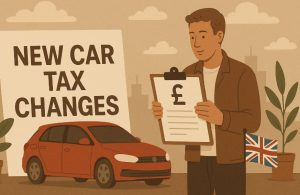Last Updated on: 7th April 2025, 04:45 am
Are you prepared for one of the biggest changes to UK vehicle tax in recent years? From April 1, 2025, the DVLA is implementing a range of updates to Vehicle Excise Duty (VED) that will affect millions of drivers.
Whether you own a petrol, diesel, hybrid, or electric vehicle, the new tax system will likely change how much you pay each year. These changes are particularly significant for older drivers and electric vehicle owners, as long-standing tax advantages are being removed or reduced.
Understanding how these changes apply to your vehicle type and registration year is essential to avoid unexpected costs. In this blog, you’ll discover how these reforms impact you and what actions you can take now to stay ahead of the rising road tax rates.
What Are the New Car Tax Changes Coming to the UK in 2025?

The UK government has announced a major update to the Vehicle Excise Duty (VED) system starting from April 1, 2025. These changes are intended to align the country’s car tax policy with its broader environmental goals and to promote fairness across all types of vehicle ownership.
One of the most significant alterations is the end of tax exemptions for electric vehicles, which previously benefited from incentives due to their low emissions.
From April, all drivers including those purchasing new electric vehicles will be required to pay a flat standard rate of £195 annually.
In addition to this, the first-year showroom tax will increase for many models, especially those with high CO2 emissions.
Plug-in hybrids, petrol, diesel, and even light goods vehicles will all see revised charges. These reforms aim to reflect the true environmental cost of operating different types of vehicles.
How Will Road Tax Vary Based on Vehicle Registration Dates?
The amount of road tax you are required to pay depends heavily on when your vehicle was first registered. The UK uses different taxation systems based on specific registration periods.
Cars Registered Before March 1, 2001
Vehicles in this category are taxed based on engine size. Cars under 1549cc now pay £220 annually, while those over 1549cc pay £360.
Vehicles Registered Between March 1, 2001 and March 31, 2017
These fall under the emissions-based band system, ranging from Band A to M. Tax rates vary significantly depending on CO2 output.
Vehicles Registered After April 1, 2017
A flat standard rate of £195 applies from the second year onward, with the first-year rate calculated based on emissions. Cars emitting over 255g/km face up to £5,490 in first-year tax.
Understanding your vehicle’s registration date is crucial for determining the exact VED you owe under the updated policy.
Why Are Older Drivers Expected to Pay More Under the New System?

Older drivers are among the most affected groups under the new 2025 car tax rules. This is not due to their age directly but rather the types of vehicles they are more likely to own.
Many senior motorists continue to drive older petrol or diesel vehicles, which emit more CO2 and fall into higher tax bands. The updates to the Vehicle Excise Duty system penalise high-emission vehicles with higher first-year and standard rates.
A significant number of older drivers also belong to the so-called ‘baby boomer’ or ‘silent generation’ groups. These motorists may struggle to switch to lower-emission or electric models due to budget constraints or familiarity with traditional engines.
Key changes include:
- Petrol and diesel cars facing doubled first-year tax in some bands
- Low-income pensioners likely to feel increased financial pressure
- Fewer older drivers owning electric or hybrid vehicles
This combination results in a disproportionate financial impact on older car owners.
What Are the Key Changes Affecting Electric Vehicle Owners?
Electric vehicles (EVs), which were previously exempt from Vehicle Excise Duty, will now be taxed under the same system as petrol and diesel vehicles.
Starting from April 1, 2025, all new and existing electric cars will face annual road tax charges, regardless of their emission status.
Main Updates for EV Owners:
- New EVs will pay a first-year showroom tax of £10
- Standard annual rate of £195 applies to all EVs registered from April 2017
- Expensive car supplement of £425 per year for EVs priced over £40,000 from years two to six
Electric vans are also no longer exempt. They will now be taxed at £355 annually, the same rate as petrol or diesel light goods vehicles.
These changes remove financial incentives that previously supported the EV market, placing electric vehicle owners on a more level footing with all other drivers.
How Will Hybrid and Alternative Fuel Vehicles Be Taxed?

From April 1, 2025, the tax advantages once enjoyed by hybrid and alternative fuel vehicles will be significantly reduced.
Previously, these vehicles benefited from lower first-year rates and slight discounts compared to traditional fuel types. The updated policy will remove those benefits and treat them equally with petrol and diesel vehicles.
What’s Changing?
- Plug-in hybrids with emissions between 1–50 g/km will now pay £110 in the first year
- All hybrid and alternative fuel vehicles move to the flat £195 annual rate
- The £10 discount for alternative fuels like LPG and bioethanol will be scrapped
By standardising rates, the government aims to simplify the system and reflect that even low-emission vehicles contribute to road wear and infrastructure demands. While hybrids still offer environmental benefits, they will no longer provide a tax-saving advantage.
What Tax Band Will Your Car Fall Into Based on CO2 Emissions?
The tax band your car falls into is primarily determined by its CO2 emissions. Vehicles with higher emissions face significantly steeper first-year charges, as the government encourages a shift toward greener alternatives. For new car buyers in 2025, these rates will see major hikes.
Updated CO2-Based First-Year Rates
- Vehicles emitting 1–50 g/km: £110
- Vehicles emitting 111–130 g/km: £440
- Vehicles emitting over 255 g/km: £5,490
These charges apply only in the first year of registration. From the second year onward, most vehicles move to a flat rate of £195, regardless of their emissions.
However, high-end models also attract additional costs. Understanding your vehicle’s CO2 emissions can help predict your upfront tax liability and possibly influence your next vehicle purchase to reduce long-term ownership costs.
How Does the Expensive Car Supplement Work in 2025?
The expensive car supplement is a recurring cost added to the standard VED for vehicles with a list price over £40,000. This policy, previously limited to petrol and diesel cars, now applies to electric and hybrid vehicles too.
Details of the Expensive Car Supplement:
- Applies from year two to year six of ownership
- Adds £425 annually on top of the standard £195
- Covers all fuel types: petrol, diesel, hybrid, and electric
So, if your vehicle exceeds the £40,000 threshold, your annual tax from year two will rise to £620. This supplement was introduced to target high-end, luxury vehicles that make a larger environmental and financial impact.
Buyers considering an electric vehicle should be aware that high-spec EVs are no longer exempt and may carry higher ownership costs than expected.
Who Qualifies for Road Tax Exemptions or Discounts?

Although most vehicle owners will see higher charges, a few groups still qualify for full or partial road tax exemptions. These exemptions help reduce costs for individuals with specific needs or qualifying vehicles.
Types of Exemptions:
- Disabled drivers receiving PIP or AFIP may receive a 50 percent discount or full exemption
- Vehicles over 40 years old (based on the date they were first registered) qualify for historic tax exemption
- Vehicles declared under Statutory Off-Road Notification (SORN) are not subject to VED
To benefit from these exemptions, you must apply through the DVLA. It is also essential to reapply or update documentation annually. Even if a vehicle qualifies for zero tax, it must still be officially taxed unless registered as off-road.
What Are the Financial Implications for New vs Existing Car Owners?
Car tax rates differ based on whether you are purchasing a new vehicle or already own one. First-year costs for new vehicles are based on emissions, while subsequent years usually fall into a flat rate category.
First-Year vs Standard Rates:
- New buyers: Higher upfront tax based on emissions
- Existing owners: Most will move to the £195 annual rate
- Pre-2017 vehicles: Continue under the previous emissions-based band system
- Pre-2001 vehicles: Taxed by engine size, now £220 or £360
This distinction affects budgeting and overall ownership costs. While a newer low-emission vehicle may be cheaper in ongoing taxes, the initial purchase can come with substantial tax charges, particularly for high-emission models.
What Will Light Goods and Vans Pay in 2025?
Commercial and light goods vehicles are also included in the 2025 VED changes. This update removes the longstanding exemption for electric vans and equalises the rates across most categories.
Tax Rates for Vans:
- Petrol and diesel vans: £355 annually
- Electric vans: Now taxed at the same £355 rate
- No first-year relief for electric models
These rates apply regardless of emissions output. While EV vans remain a more environmentally conscious choice, their cost advantage is now reduced.
Businesses and individual van owners should factor in these new VED costs when purchasing or leasing vehicles after April 1, 2025.
How Can You Minimise the Impact of the 2025 Car Tax Changes?

Although the tax changes are mandatory, there are still ways to reduce your long-term expenses. Choosing the right vehicle and timing your purchase can make a significant difference.
Practical Steps to Lower Tax Costs:
- Choose low-emission vehicles: They attract lower first-year tax
- Avoid models over £40,000: To sidestep the expensive car supplement
- Consider nearly-new vehicles: Pre-registered cars may be taxed under current rates
- Check for eligibility: Some exemptions and discounts may apply based on personal circumstances or vehicle age
Staying informed and using available tools like DVLA’s tax checker can help you make cost-effective decisions and avoid unexpected charges in the years ahead.
VED Rates by Vehicle Type and Emission Band
Understanding the 2025 Vehicle Excise Duty (VED) changes is much easier when comparing them against previous rates.
The table below outlines how tax rates have changed across various vehicle categories and emission levels. It provides a quick reference for new and existing car owners trying to calculate their annual and first-year tax liabilities under the new system.
VED Comparison Table (Pre-2025 vs Post-2025)
| Vehicle Type / CO2 Emissions or Classification | Pre-2025 First-Year Rate | 2025 First-Year Rate | Standard Rate (2025) | Additional Charges (if any) |
| Electric Vehicles (EVs) | £0 | £10 | £195 | £425 annual supplement if over £40,000 (years 2–6) |
| Plug-in Hybrids (1–50 g/km) | £0 | £110 | £195 | None |
| Petrol/Diesel (111–130 g/km) | £220 | £440 | £195 | £425 if over £40,000 |
| Petrol/Diesel (Over 255 g/km) | £2,745 | £5,490 | £195 | £425 if over £40,000 |
| Light Goods Vehicles (Petrol/Diesel) | £345 | Flat £355 from registration | £355 | None |
| Electric Vans | £0 | Flat £355 from registration | £355 | None |
| Cars Registered Before 2001 (<1549cc) | £210 | Flat £220 | £220 | None |
| Cars Registered Before 2001 (>1549cc) | £345 | Flat £360 | £360 | None |
| Cars Registered 2001–2017 (Band A–M) | Based on Band (e.g. Band D: £135) | Based on Band (unchanged) | No change to banded rates | £425 if vehicle over £40,000 (select bands) |
Key Considerations for Vehicle Owners in 2025:
Electric vehicles will no longer benefit from the Vehicle Excise Duty (VED) exemption and will be taxed in line with petrol and diesel vehicles. This includes a first-year charge and a standard annual rate applicable from April 1, 2025.
The expensive car supplement is another important factor. It applies to any vehicle with a list price exceeding £40,000, regardless of whether it is petrol, diesel, hybrid, or electric. This adds £425 annually from the second to the sixth year of ownership.
Light Goods Vehicles (LGVs), including electric vans, are now subject to a flat VED rate of £355, with no discounted first-year rate applied.
Owners of classic vehicles over 40 years old may qualify for exemption but must apply to receive it.
Additionally, vehicles declared under Statutory Off-Road Notification (SORN) remain exempt, provided the declaration is correctly submitted.
This breakdown helps drivers understand the exact cost implications for their specific vehicle type. Whether you are buying new, own an older model, or are considering switching to electric, knowing these figures can help with future planning and budgeting.
Conclusion
The 2025 car tax changes mark a clear shift in the UK’s approach to road funding and emissions management. With incentives for electric vehicles ending and higher charges imposed on high-emission and older cars, almost every driver will notice a difference in their yearly vehicle tax bill.
Older motorists may feel the financial pressure most, while new car buyers must factor in significantly increased first-year rates. The changes also encourage cleaner, lower-emission choices, but with fewer financial rewards than before.
Understanding your vehicle’s classification and tax band is now more important than ever. Planning ahead and considering alternatives such as lower-emission vehicles or nearly-new purchases could help reduce the cost burden. Staying informed will be the key to navigating the new system smoothly and avoiding costly surprises.
FAQs
How do I find out which tax band my car falls into?
You can check your car’s VED band by using your registration date and CO2 emissions rating, available on your V5C logbook or through the DVLA’s official tax checker tool online.
Will I pay more if I buy an electric vehicle after April 2025?
Yes, all new electric vehicles registered from April 1, 2025 will pay a £10 first-year rate and an annual standard rate of £195, plus £425 annually if the vehicle costs over £40,000.
Are older petrol and diesel vehicles taxed more than newer models?
In most cases, yes. Older cars typically emit more CO2 and fall into higher tax bands, making them more expensive under the emissions-based VED structure now in place.
Do plug-in hybrid vehicles still get any tax discounts?
Not anymore. From April 2025, plug-in hybrids will pay £110 in the first year and £195 annually afterward, losing the previous discount they had over conventional fuel vehicles.
What is the expensive car supplement, and who does it affect?
The supplement adds £425 per year for five years to any vehicle with a list price over £40,000. It applies to all fuel type,s including EVs and hybrids.
Are electric vans taxed the same as petrol or diesel vans?
Yes, electric vans now face the same £355 annual flat rate as petrol and diesel light goods vehicles. The previous exemption for EV vans no longer applies.
Can I avoid the new tax rates by buying a used vehicle?
You might. Buying a nearly-new or pre-registered car before April 1, 2025 may let you avoid the higher first-year rates if it’s already been taxed under the current system.




















No Comments
Leave a comment Cancel